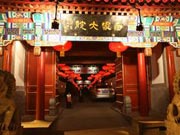

 |
China's Strategy
As the second largest economy in the world, China has maintained a steady trade and development approach towards its regional neighbors. As a country with low per capita allocations of natural resources, China is dependent on its trade routes. For instance, the "One Belt and One Road" concept (OBOR) will diversify China's ability to receive resources and shipped goods, while it connects China to markets with massive natural resources, accounting for 63 percent of the world's population, a GDP of 2.1 trillion US dollars, but only 29 percent of the world's output. Essentially, this is a golden opportunity for a country like China that needs natural resources to make products and markets to sell them in.
China's New Playbook
China is in the midst of a massive retooling of its economy, as it seeks to avoid the "Middle Income Trap", which has stymied so many other emerging countries. The goals, as indicated by Chinese Premier Li Keqiang at the NPC and CPPCC meetings, are to deleverage the inefficient excess capacity of China's SOEs, make the finance and governance of its companies more market driven, accelerate the quality of its growth with more sustainable innovation and entrepreneurship, and clean up and streamline governance overall.
In short, while China's ultimate future will depend on its ability to compete with economies in Europe, North America and the rest of Asia, today it faces the process of managing the transition. Part of this involves utilizing the current production capability and assets which keep factories open and people working; another part involves strengthening the logistical and development infrastructure of its neighbors, so that they have a stable base to grow their economies and societies. This has been one of the main drivers pushing the series of international and regional infrastructure development initiatives introduced by China's leadership. These include the BRICS Bank, the "One Belt and One Road" initiative, the expansion of the Shanghai Cooperation Agreement into infrastructure, numerous signed and negotiated bilateral and multilateral trade agreements and the Asian Infrastructure Investment Bank (AIIB).
Historical Frustrations
The other part of the story is the frustration China has felt at being left out of the financial decision making process at the traditional international funding institutions, the World Bank, the International Monetary Fund (IMF) and the Asian Development Bank (ADB). All three institutions were legacies, in one way or another, of Bretton Woods, which created the foundations of the post-World War II financial system, which put the US and the Dollar in leading positions.
Despite recommendations from within the IMF and World Bank, the US has steadfastly stalled any reforms which would provide a larger role for China. The other part of this equation, which does not fit the Chinese international development model, is the inclusion of political and economic requirements, beyond the simple repayment of funds. As China's policy emphasizes trade and development and non-interventionism, China tends to clash with the political and economic requirements that come with the loans from these institutions. The third issue is that these institutions have become very unwieldy, bureaucratic and politically dominated. The combination of these three factors has pushed China to think outside the box set up by Bretton Woods and look at developing financing mechanisms that fit China's desire for more sustainable regional and international development.
New Goals for a New Kind of Bank
The goal of the AIIB is to provide infrastructure investment funds that help Asia-Pacific countries develop their internal and regional economies. In 2010 the ADB, which is dominated by Japan and the US, estimated that the Asia-Pacific region would need 8 trillion US dollars in infrastructure improvements before 2020. The ADB has less than 200 billion US dollars in total capital and is able to lend only about 10 billion a year. To address this need China has given an open invitation to all interested countries to become founding members of the 50-billion-dollar AIIB. To date 33 countries have voiced an interest. The actual articles of the AIIB have not been set up, but with less than a week and a half until the deadline to be included in the next planning phase, countries are scrambling to keep their options open.
The greatest surprise to date has been the interest by European and southern Pacific countries and the open and cloaked opposition by the US, which has gone so far as to publicly scold Great Britain for indicating an interest. When France and Italy indicated a desire to be included, additional negative statements were issued by the Obama administration. In the background, the US has been lobbying South Korea, Japan and anyone who will listen about the dangers of such a bank.
Unfortunately, it comes at a time when the US is offering no substantial alternative alongside the unhappiness of a number of traditional EU allies with the US on the Ukraine and Middle East issues.
Ideological Opposition
The opposition to the China-proposed AIIB comes mostly from the US and Japan who see any alternative structures to the Bretton Woods scheme as an erosion of their interests. Some of the countries cite the emphasis from the US, EU, Japanese and Australia on standards of governance, environmental and social safeguards and transparency.
But in the end, the AIIB cannot and should not be a copy of the ADB, IMF or World Bank. These institutions have been in place for the last 70 years, but the world has moved on; it is time for institutions which reflect the needs and realities of today. It is highly probable that this means that loans will be based on need and ability to repay rather than political or economic ideology.
The larger issues involved in the opposition to the AIIB are the result of distrust and cultural differences between the US and China. The distrust is based on the US's concern about China's growing political, economic and cultural influence, which Washington sees as a zero sum game. The cultural differences stem from the US view of American Exceptionalism, which assumes that only a country that accepts capitalism, democracy and Christianity can be legitimate and lasting. It is reflected in the US approach to Asia which emphasizes trade and security, as opposed to China's trade and development. Unfortunately with a "lame duck" president and a hostile congress there is even less chance of reaching a mutual understanding on such an issue.
Benefits
To continue their rapid development, the Asia-Pacific countries need major investment for all types of infrastructure. A lack of roads, railways, airports, ports, power stations, water works, sewers, hospitals and schools are among the biggest development barriers facing the region. In many cases these countries are heavily dependent on sales of raw resources, which put them at the mercy of boom and bust cycles of world demand. Their lack of ability to refine, process and manufacture their resources into goods keeps them at the low end of the value chain and thus the economic system. In addition, their financial infrastructure is weak and can be more easily affected by unstable money flows and currency fluctuations. Having numerous investment banks which emphasize different goals should be a desirable outcome for technologically robust developed economies looking for markets that can afford their products and services. But, until the US accepts this, it risks being increasingly isolated by other countries that see this as desirable.
Opportunities
For countries that participate and companies who can get involved, this could usher in a new era of opportunities both short and long term. In the short term, while China has natural price advantages in certain industries, the breadth and scope of what is needed is well beyond anything China could provide by itself. In the long term, these types of investments will open reliable alternative production and sales markets which could further enhance the profitability of developed countries' supply chain economics. For the developing countries, it is a chance to climb the value ladder and develop stand-alone economies which can withstand global economic cycles. People should keep in mind that the rapid peaceful economic rise of China has already and will continue to create massive profits for companies and countries around the world.
For China, the challenge is whether an increasingly isolated US becomes more intractable and less of a global player. With its massive resources, advanced technology and military power, the US is an essential partner in maintaining world order at a time when separatism and extremism has become rampant. The real issue is how China and the US can cooperate well in today's multi-polar world.
Day|Week

 Tsinghua junior makes over 10,000 yuan a day by selling alumnae's used quilts
Tsinghua junior makes over 10,000 yuan a day by selling alumnae's used quilts Graduation photos of students from Zhongnan University
Graduation photos of students from Zhongnan University A school with only one teacher in deep mountains
A school with only one teacher in deep mountains Glimpse of cultural heritage "Xilankapu"
Glimpse of cultural heritage "Xilankapu" Homemade cured hams in SW China
Homemade cured hams in SW China Breathtaking buildings of W. Sichuan Plateau
Breathtaking buildings of W. Sichuan Plateau Graduation photos of "legal beauties"
Graduation photos of "legal beauties" Top 10 most expensive restaurants in Beijing in 2015
Top 10 most expensive restaurants in Beijing in 2015